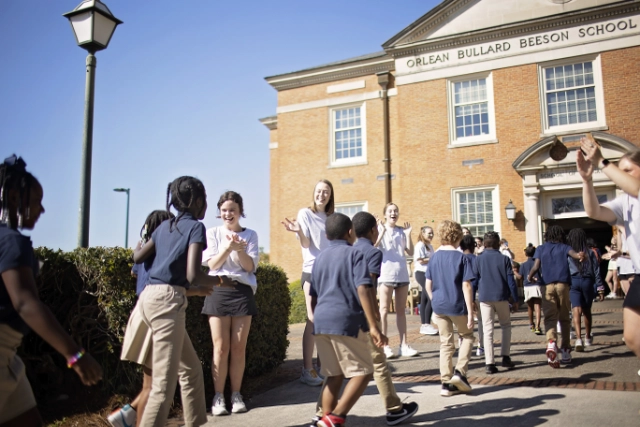
Orlean Bullard Beeson Hall recently underwent a renovation that was out of this world. Juniors in the Early Childhood Special Education, Elementary and Collaborative programs, along with several faculty members, transformed the education building from top to bottom into a galactic environment fit to welcome 67 second-grade students from i3 Academy who joined the school as space cadets for STEAM Academy.
Stars hung from the ceiling and covered the walls, aliens and astronauts roamed the halls and students participated in a variety of activities that created opportunities for personal application and fun.
“We started planning after Spring Break and so we had some class time, but most of this was outside of class time. Students took the initiative to plan the skits, the groups, how it would look and feel for the day, and hosting the 2nd graders,” said Luci Sobanski, a junior studying elementary education.
STEAM Academy was designed to share the importance of STEAM, an approach to teaching and learning that integrates science, technology, engineering, art and mathematics through real-world, hands-on, inquiry-based pedagogy. STEAM education supports students’ creativity, ingenuity and curiosity, and helps develop their critical thinking and problem-solving skills. Research has also shown STEAM education increases student achievement and interest in these subjects.
“Young children are naturally inquisitive, imaginative, creative and curious. They tend to explore the world around them and ask questions to understand what they observe. Why is the sky blue? How do birds fly? Exposing children to STEAM when they are young through events such as STEAM Academy capitalizes on children’s curiosity and natural interest in STEAM,” said Kari Jurgenson, an assistant professor of teacher education.
Upon arrival, second graders were introduced to their pen pals, School of Education students that were paired with i3 Academy students in the early fall. Education students have been corresponding with their pen pals, encouraging them and getting to know them.
“It was amazing to get to know students that we have never met and get to talk to them throughout the year. The learning opportunity from it, learning how kids write, the writing level they are at, was an authentic way for us to experience what we have been learning about in class,” said Sobanski.
The elementary school students rotated among six different exploratory and hands-on stations each offering a different area of focus. The first, “IMPACT!” explored the process by which craters are formed. Students created their own craters by dropping asteroids (golf balls, bouncy balls, tennis balls, pebbles) onto the surface of the moon (plastic bins filled with flour or sand) from varying heights. The little scientists then measured the diameter of each crater and drew conclusions from the data they gathered to determine how the height of the drop and the size of the asteroid impacted the size of the crater formed.
The second station, “Constellation Station,” taught students about the different shapes and lines that form the night sky and then created different constellations using pretzel sticks and mini marshmallows. Then, students used their creativity to create their very own constellation, craft a story about it and share it with others.
At the third station, “Going on a Trip—Bee Bots Space Tour,” students learned about different planets and how to use Bee Bots. Students went on a tour of space by coding Bee Bot robots to reach each planet in the Milky Way. Once the Bee Bot arrived at each planet, the young astronauts learned about that planet and received a stamp in their Milky Way passport to indicate they successfully programmed and coded their Bee Bot robot to travel to that planet.
The fourth station, “3, 2, 1, Blast Off!” exposed students to how and why rockets launch into space. Children discussed why people go into space, watched a video of a rocket launch, and then created their own rockets using plastic straws. After the little engineers built and tested their rockets, they discussed what made the rockets fly, the forces at play, and ways they could make their rockets go farther.
The fifth, “Potato Space Suit,” had students act like engineers as they created, tested and evaluated a spacesuit that could withstand an external force, just as real spacesuits do in outer space. The students engaged in the engineering design process as they created a spacesuit to protect their astronaut, a potato, using materials such as tin foil, rubber bands and tissue paper. They tested each spacesuit’s success by jabbing their potato with a straw. After the young engineers evaluated which materials were more or less effective they discussed how this activity is similar to the work scientists and engineers do.
The sixth station, “Marvelous Moon Terrain,” exposed students to a video of a moon rover driving across the surface of the moon, then students were able to try it themselves in a simulation. Students coded and programmed Dash and Dot robots (moon rovers) to navigate the rough, moon-like terrain successfully. Through this activity, students were able to better understand the terrain of the moon and how scientists and engineers use rovers to navigate and explore the moon’s surface.
Students from i3 Academy also enjoyed lunch on the Quad and a visit to Christenberry Planetarium. Here, students explored the scale of our solar system and took a tour, visiting each planet and learning the features of each planet that make it unique.
“Research continuously shows that early exposure to STEAM positively impacts students’ perceptions of these fields,” said Jurgenson, “This curriculum provides children the opportunity to act and think like scientists, engineers and mathematicians. Early exposure to STEAM allows children to learn concepts through hands-on, authentic activities in which they can dive-in, play, build, explore and share what they have learned.”
